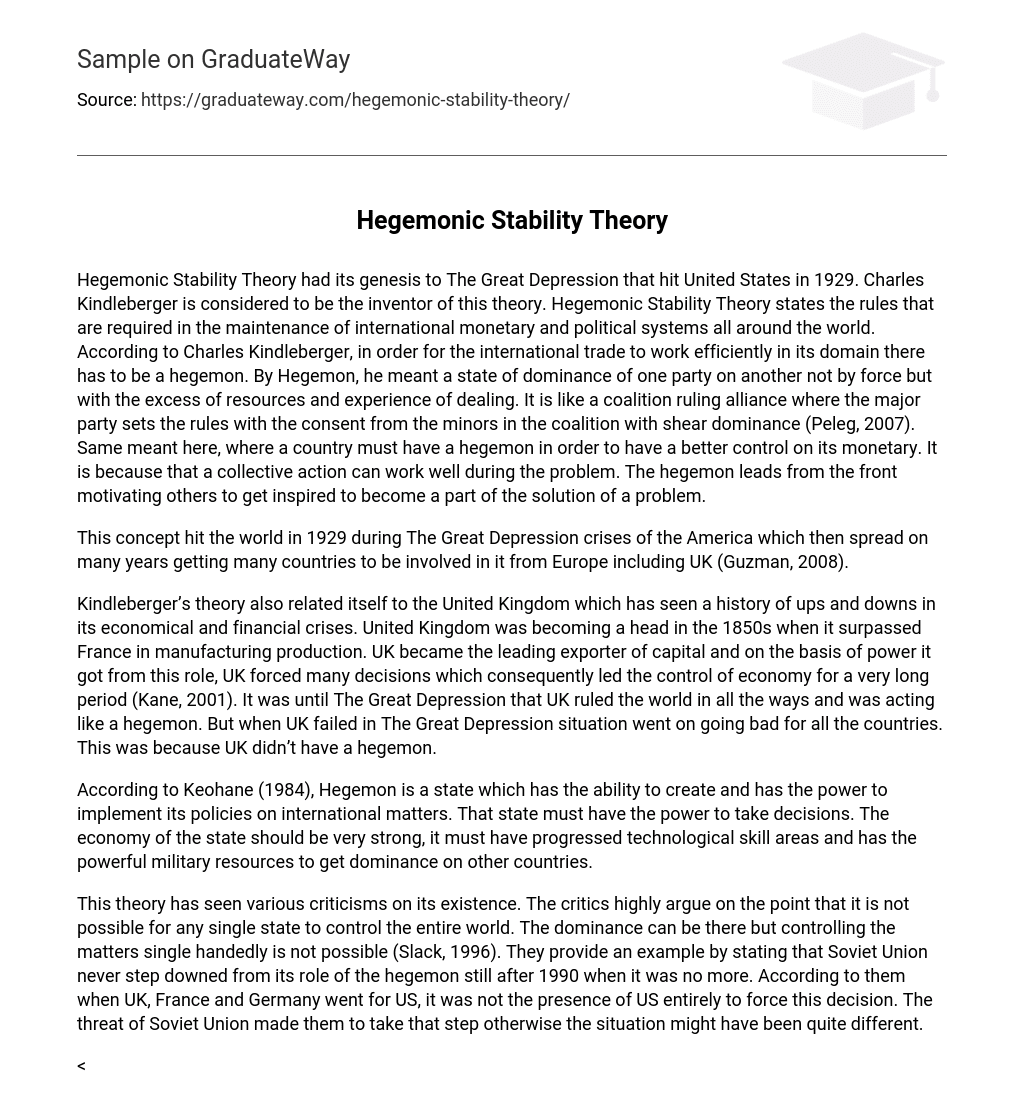Hegemonic Stability Theory had its genesis to The Great Depression that hit United States in 1929. Charles Kindleberger is considered to be the inventor of this theory. Hegemonic Stability Theory states the rules that are required in the maintenance of international monetary and political systems all around the world. According to Charles Kindleberger, in order for the international trade to work efficiently in its domain there has to be a hegemon. By Hegemon, he meant a state of dominance of one party on another not by force but with the excess of resources and experience of dealing. It is like a coalition ruling alliance where the major party sets the rules with the consent from the minors in the coalition with shear dominance (Peleg, 2007). Same meant here, where a country must have a hegemon in order to have a better control on its monetary. It is because that a collective action can work well during the problem. The hegemon leads from the front motivating others to get inspired to become a part of the solution of a problem.
This concept hit the world in 1929 during The Great Depression crises of the America which then spread on many years getting many countries to be involved in it from Europe including UK (Guzman, 2008).
Kindleberger’s theory also related itself to the United Kingdom which has seen a history of ups and downs in its economical and financial crises. United Kingdom was becoming a head in the 1850s when it surpassed France in manufacturing production. UK became the leading exporter of capital and on the basis of power it got from this role, UK forced many decisions which consequently led the control of economy for a very long period (Kane, 2001). It was until The Great Depression that UK ruled the world in all the ways and was acting like a hegemon. But when UK failed in The Great Depression situation went on going bad for all the countries. This was because UK didn’t have a hegemon.
According to Keohane (1984), Hegemon is a state which has the ability to create and has the power to implement its policies on international matters. That state must have the power to take decisions. The economy of the state should be very strong, it must have progressed technological skill areas and has the powerful military resources to get dominance on other countries.
This theory has seen various criticisms on its existence. The critics highly argue on the point that it is not possible for any single state to control the entire world. The dominance can be there but controlling the matters single handedly is not possible (Slack, 1996). They provide an example by stating that Soviet Union never step downed from its role of the hegemon still after 1990 when it was no more. According to them when UK, France and Germany went for US, it was not the presence of US entirely to force this decision. The threat of Soviet Union made them to take that step otherwise the situation might have been quite different.
Secondly, it was also stated that during the World War II, the economical system of the world destroyed not because there was no hegemon, but because the Germany had taken harsh steps to destroy everything in its way including the economy as well.
The critics also say that there can be more than two hegemon at the same time due to the military resources. Economically it might not happen, but on the account of military it is highly possible and both the hegemons can work against each other to destabilize each other forming a bad affect on the economical system (Guzman, 2008). It is also stated that hegemon cannot last for long. We have seen history where the control of the world started from UK, then transferred to Germany, USSR and then USA.
In the newer version of this theory, hegemon is no longer has the righteous policies. That is, the hegemon now will only look at its interest rather than others (Slack, 1996). Hegemon can create, make and change the monetary system as it likes. Also previously it was said that a single hegemon cannot last long, so with the fall of hegemon the economical system also goes down creating economical and financial crises. Having a hegemon can be very dangerous in these situations as well.
Hegemon state is nowadays known as the superpower (Joseph, 2002). The word was transferred from USSR to US. Hegemon was very reluctant to work in the framework order it was provided and the superpower only knows how to dominate the world economically and militarily.
References
Keohane, Robert O. (1984). After Hegemony: Cooperation and Discord in the World Political Economy. New York: Princeton University Press.
Joseph, Jonathan. (2002). Hegemony: a realist analysis, New York: Routledge.
Slack, Jennifer Daryl. (1996). “The Theory and Method of Articulation in Cultural Studies”, in Morley, David; Chen, Kuan-Hsing, Stuart Hall: Critical Dialogues in Cultural Studies, London: Routledge.
Friedman, Jonathan and Chase-Dunn, Christopher. (2004). Hegemonic Decline: Present and Past. New York: Paradigm Publishers.
Jackson, Robert and Sorensen, Georg. (2007). Introduction to International Relations: Theories and Approaches. New York: Oxford University Press.
Emerson M. S. Niou, Peter C. Ordeshook, and Gregory F. Rose. (1989). The Balance of Power: Stability in International Systems. London: Cambridge University Press.
Steve Smith, Ken Booth, and Marysia Zalewski. (1996). International Theory: Positivism and Beyond. London: Cambridge University Press.
Kane, John. (2001). The Politics of Moral Capital. London: Cambridge University Press.
Peleg, Ilan. (2007). Democratizing the Hegemonic State: Political Transformation in the Age of Identity. London: Cambridge University Press.
Guzman, Andrew T. (2008). How International Law Works: A Rational Choice Theory. London: Oxford University Press.





